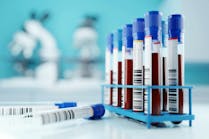Over the past 20
years, the incidence of infections caused by antimicrobial-resistant
pathogens including methicillin-resistant
Staphylococcus aureus (MRSA) has increased dramatically,
especially in patients in intensive-care units (ICUs) and those who are
immunocompromised.1 In addition, the appearance of
community-associated MRSA has increased the burden of this organism in
hospitals and in the community.
Newark Beth Israel Medical Center (NBIMC) enacted
measures in August 2005 to aggressively seek out the potentially
dangerous infection. The screening was initially done by conventional
cultures; but with the advent of rapid detection DNA-based real-time
polymerase chain reaction (PCR) technology, NBIMC quickly transitioned
in March 2006. This technology allows detection of the organism’s mecA
gene in approximately two hours. NBIMC was the first healthcare facility
in New Jersey to adopt this technology for establishing a strategy known
as active MRSA surveillance.
Testing began in the neonatal ICU at NBIMC,
followed by the adult ICU and cardiac critical care units. Today, every
patient admitted to these units is tested for MRSA, even if he shows no
sign of the infection. Over the past year, testing of all incoming adult
ICU patients reduced the rate of newly acquired MRSA infections to
almost zero. Also, this new approach cut the proportion of ICU patients
colonized with MRSA by half — to 15% from 33% — by reducing the number
of colonized patients re-admitted to the ICU.
Understanding MRSA
Decades ago in
hospitals, a strain of staph emerged that was resistant to the
broad-spectrum antibiotics commonly used to treat it. MRSA, which makes
up more than 60% of hospital staph infections, was one of the first
germs to overpower all but the strongest antibiotics. It has shown
resistance to antibiotics including methicillin, oxacillin, penicillin,
and amoxicillin. Today, MRSA is responsible for many serious skin and
soft-tissue infections and for a potentially deadly form of pneumonia.
A study in the October 2007 issue of the
Journal of the American Medical Association reported that in the
hospital, MRSA infections are associated with greater lengths of stay,
higher mortality, and increased healthcare costs. The researchers
concluded that invasive MRSA disease is “a major public-health problem.”
Recently, legislative measures aimed at
controlling antimicrobial-resistant pathogens in healthcare facilities
were introduced in 24 states.2 The proposed legislation
mandates the use of active-surveillance cultures to screen hospitalized
patients who might be carrying MRSA.
MRSA: the economic impact
Based on
the Centers for Disease Control and Prevention (CDC) figures that
approximately 126,000 persons are hospitalized each year with MRSA
infections3 and about 19,000 die,4 researchers
estimated the annual cost to U.S. hospitals to be $3.2 billion to $4.2
billion.5 The researchers found the direct medical cost to
range from $27,083 to $34,900 per case.3
Even with the additional cost of the tests, the hospital saved
about $1.5 million in both the NICU and ICU last year.
Newer data suggest that the drug-resistant
bacteria strain could be more common than previously thought. A study by
the Association for Professionals in Infection Control and Epidemiology
(APIC) surveyed infection rates at more than 1,200 healthcare
facilities, including about one in five U.S. hospitals, found that 34 of
every 1,000 patients were infected with MRSA.6
Recent studies have shown that infections caused
by antimicrobial-resistant pathogens are associated with decreased
clinical outcomes and an increased cost of care, compared with
infections caused by antimicrobial-susceptible strains of the same
bacteria. High costs are incurred from treating MRSA, mainly due to
prolonged hospital stays including time spent in ICUs. Patients with
MRSA infections may be in the hospital 10 days longer than patients with
staph infections not resistant to methicillin.3
Screening means savings
NBIMC’s rapid-testing regimen cut
spending on vancomycin — the antibiotic of last resort for
virulent infections — by $57,000 in 2007. In the NICU alone, it
is estimated that testing had saved $960,000 in 2006 by reducing
the infection rate dramatically. Even with the additional cost
of the tests, the hospital saved about $1.5 million in both the
NICU and ICU last year. In the NICU, NBIMC estimated the cost
attributable to MRSA infection at $48,000 per patient; that cost
in the adult literature was estimated to be $31,400. The length
of hospitalization was more than double — 10.0 days for MRSA
infections vs. 4.6 days for all other stays. Only about 28% of
hospitals nationally use active surveillance to identify
patients carrying MRSA without active symptoms, according to the
APIC study,6 and only a small percentage use the
rapid molecular technology.
How NBIMC implemented a successful MRSA initiative
In August 2005, NBIMC instituted a
sweeping set of measures that sharply decreased infection rates.
After 12 months of testing every patient entering the ICU, the
new system reduced new infections by MRSA to nearly zero.
Initial MRSA screening began in the NICU in August 2005. Testing
was initially done by conventional culture, but the advantages
of the rapid technology became readily apparent. Testing is now
performed on all babies admitted to the NICU. Rigorous
surveillance efforts have led to zero infections for 12 months
in the NICU. In the first year of screening, 22 colonized babies
were found positive on admission. A separate study done at NBIMC
showed that almost 10% of its pregnant women were colonized with
MRSA at the time of delivery. The testing process in the NICU
was so successful that NBIMC staff extended the process to the
adult ICU, where initial screenings showed about 30% of admitted
patients tested positive for nasal colonization with MRSA. These
rigorous surveillance efforts have led to almost zero infections
over 12 months in the ICU.
Today, all newly admitted patients to the
NICU/adult ICU are screened for MRSA colonization by using nasal swabs.
These patients are put on pre-emptive isolation while waiting for their
test results. Rapid PCR test results can be completed within two hours
and have significantly reduced the duration that patients are put in
isolation. When the laboratory alerts the patient-care team by telephone
of any positive results, patients found to be colonized are immediately
treated with a topical antibiotic called mupirocin. By rapidly
identifying them, NBIMC has lowered these patients’ risk of progression
to more serious infections and also has reduced transmission of MRSA
from patient to patient within the unit.
The PCR technology also has the advantage of
being more sensitive than traditional cultures. Used as a screening
tool, MRSA real-time PCR detects more positive cases than a traditional
culture and appears to have a superior sensitivity for samples with low
bacterial load or a history of antibiotic treatment. Compared to
cultures, DNA-based methodology has the advantage of more accurately
detecting organisms inhibited by antibiotics. It is less likely to give
false-negative results in samples of low bacterial load or those from
partially treated patients. Not surprisingly, many of the discordant
results (PCR-positive and culture-negative) were on follow-up samples
from patients who had recently been or were being treated by antibiotics
for MRSA.
Conclusion
Because of the increase in
community-based MRSA, it can be expected to be a larger problem
in both the hospital and community in the near future. If the
prevalence of MRSA is increasing in any hospital units, consider
screening and colonization as active measures to reduce this
costly threat. Through pre-emptive
infection-prevention-and-intervention strategies, including
active-surveillance cultures with rapid detection technology,
hand hygiene, barrier precautions (e.g., gloves and masks),
antibiotic control, suppression and eradication of colonization,
and environmental disinfection, Newark Beth Israel Medical
Center has successfully reduced the rate of newly acquired MRSA
infections to almost zero in those units under active
surveillance. By creating your own hospital blueprint for MRSA
reduction, your facility can implement a successful MRSA
initiative.
Jeremias Murillo, MD, is vice
president of Clinical Services within The Saint Barnabas Health Care
System; and
Patricia Tsang, MD, MBA, is chairperson of the
Department of Laboratory Medicine and Pathology at Newark Beth Israel
Medical Center. NBIMC uses BD’s GeneOhm MRSA Assay for screening its
patients.
References
1. Weber SG, Huant SS, Oriola S, Huskins WC,
Noskin GA, Harriman K, et al. Legislative mandates for use of active
surveillance cultures to screen for methicillin-resistant
Staphylococcus aureus and vancomycin-resistant enterococci:
Position statement from the Joint SHEA and APIC Task Force.
American Journal of Infection Control. 2007;35(2), 73-85.
2. Association for Professionals in Infection
Control & Epidemiology. HAI reporting laws. 2007.
http://www.apic.org/am/images/mandatory_reporting/mandrpt_map.gif.
Accessed February 28, 2008.
3. Kuehnert MJ, Hill HA, Kupronis BA, Tokars
JI, Solomon SL, Jernigan DB. Methicillin-resistant Staphlococcus
aureus hospitalizations, United States. Emerging Infectious
Diseases. 2005;11(6);868-872.
4. Klevens RM, Morrison MA, Nadle J, Petit S.
Gershman K, Ray S, et al. Invasive methicillin-resistant
Staphylococcus aureus infections in the United States. The
Journal of the American Medical Association.
2007;298(15);1763-1771.
5. U.S. Outcomes Research Group of Pfizer
Inc. Poster session presented at the May 2005 annual meeting of the
International Society for Pharmacoeconomics and Outcomes Research,
Washington, DC.
6. Association for Professionals in Infection
Control & Epidemiology. Methicillin resistant Staphylococcus aureus
(MRSA) 2007 study results.
http://www.apic.org/Content/navigationMenu/ResearchFoundation/NationalMRSAPrevalenceStudy/
APIC_MRSA_STUDY/EXEC2.pdf. Accessed February 28, 2008.
Starting your own active MRSA surveillance program
NBIMC’s blueprint for MRSA reduction is as
follows:
- Phase 1: Risk assessment, selection, and planning
- Conduct risk assessment to identify the high-risk unit, and to
begin screening and decolonization. - Meet with lab leadership to outline the implementation process
and to develop an estimate of lab resources. - Meet with information-technology personnel to capture all
admissions to the selected unit. - Meet with key physician and nursing leaders of the selected unit
to plan the implementation process. - Share the baseline data with physicians, nursing leadership, and
staff-level nurses. - Conduct front-end education of all unit personnel.
- Select a start date.
- Phase 2: Implementation and maintenance
- Screen all admissions to the unit by obtaining nasal swabs, and
test for MRSA using either culture or PCR-based technology and
culture for confirmation. - Decolonize all patients with positive nasal swabs using topical
mupirocin twice daily for seven days. - Repeat nasal swabs 24 hours after the last mupirocin dose to
document resolution of the colonization before discontinuing isolation;
flag patients who fail decolonization. - Obtain daily reports of positive nasal swabs and reconcile with
admission list. - Meet with unit leadership at least weekly to resolve
implementation problems in a timely manner. - Implement an education process for patients and their families.
- Phase 3: Data analysis and trending
- Maintain data on number of admissions, number tested, number
colonized, and number of infected patients on a monthly basis; use
this data to track and demonstrate improvement over time. - Monitor MRSA infections in other units (as part of ongoing risk
assessment) to determine whether the process has impacted overall
MRSA rates. - Feedback outcome data monthly to physicians, nursing leadership,
staff-level nurses, and lab leadership to revitalize commitment to
this process. - Some guidelines to consider when starting an active
surveillance program: - Newer rapid molecular-testing methods are the ideal technology
for implementing active-surveillance measures on patients upon
admission, eliminating the two to three days associated with
traditional culture methods. - At NBIMC, patients who are infected or colonized with MRSA are
placed in isolation to prevent its spread to other patients and
healthcare workers; visitors to and healthcare workers caring for
isolated patients may be required to wear protective garments and
must follow strict hand-washing procedures. - As in every large-scale improvement process that affects most
areas of a hospital, reducing MRSA infections requires strong
leadership; if upper management supports the initiative, that
message will be better conveyed and better implemented. - An involved, educated nursing staff will result in better
compliance; review the high cost of MRSA infection and the increased
risk to already-sick patients. - Hand washing at the bedside is still the hallmark of infection
prevention, even with all the newest technological advances; to
prevent the spread of germs, healthcare workers should wash their
hands frequently, properly disinfect hospital surfaces, and wear
masks when caring for patients with weakened immune systems.
Help avoid MRSA’s spread
—Chris Kosobud
Healthcare Marketing
Kimberly-Clark Professional
Roswell, GA
Q How can medical
laboratories help prevent MRSA outbreaks, and how should lab personnel
clean and disinfect once a MRSA outbreak happens?
A Staph/MRSA can survive
for weeks to several months on almost all hard surfaces. Staph/MRSA
infections can occur when a person who is at risk touches a surface
contaminated with Staph/MRSA bacteria or has skin-to-skin contact.
Staph/MRSA can be killed by cleaning and disinfecting surfaces with
bleach and other disinfectants such as quaternary amines. In addition to
proper hand hygiene, cleaning and disinfecting surfaces can help to
minimize the transfer of microorganisms that can occur via hand contact
between contaminated surfaces and people. Not all disinfecting practices
are the same, however. Previously underestimated factors, like the type
of cloth or wiper used to apply the disinfectant to the surface, may
dramatically affect the concentration of active ingredients delivered to
surfaces. In studies, common cotton rags and paper wipers/towels, when
used with an open bucket of cleaning solution, show a decline in the
concentration of active ingredients. Instead, look for non-woven wipers
that have a fiber preparation specifically designed to be compatible
with quaternary amines or bleach to improve the delivery of the
disinfectant chemical to the surface.
Using procalcitonin to diagnose sepsis and the potential for
improved antibiotic stewardship
Increased rates of
infection with antimicrobial-resistant bacteria, especially methicillin-resistant
Staphylococcus aureus
(MRSA), have focused attention on early detection of such “superbugs” and
the adoption of measures to control their spread. Similarly, the increased
incidence of sepsis, an unusual systemic response to infection which occurs
in some patients, has stimulated great interest in identifying infected
patients at risk and intervening early. When this condition progresses to
severe sepsis (characterized by organ dysfunction) and septic shock
(associated with hypotension), mortality is high. Like MRSA, sepsis is no
longer limited to hospitalized patients but has begun to appear as a
potential complication of community-acquired infections, especially
pneumonia. Patients with suspected severe sepsis now account for over
500,000 emergency department (ED) visits annually.1
An international consensus conference, the “Surviving
Sepsis Campaign,” reviews and grades standards of care for patients with
severe sepsis, based on available evidence. The first report was published
in 2004; revised guidelines were published this year.2 At
Stanford Hospital, we implemented many of the recommendations and have seen
a reduction in our mortality rate for hospital-acquired severe sepsis and
septic shock from 56% in 2005 to 33% so far this year. We hope to reduce
this further, and we are also focusing on new approaches to diagnosing
sepsis, especially at an early stage, so that these advances in treatment
can be even more effective.
Several international consensus conferences have
addressed the definition of sepsis — infection associated with the so-called
systemic inflammatory response syndrome (SIRS). High white-blood-cell count
(or elevated immature white blood cells) is one of the original criteria for
SIRS. The most recent sepsis definition conference suggested an expansion of
the diagnostic criteria, and several of the additional variables also
involve the clinical laboratory.3 These include hyperglycemia
(with no history of diabetes mellitus); coagulation abnormalities; markers
of organ dysfunction or decreased tissue perfusion such as bilirubin,
creatinine, and lactate; and additional inflammatory markers such as
C-reactive protein (CRP) and procalcitonin (PCT).
Most laboratorians are familiar with CRP as a marker
of inflammation but may not recognize the role that PCT can play in the
laboratory diagnosis of infection. In healthy individuals, only the
specialized C-cells in the thyroid gland transcribe and translate the gene
for PCT, and they process this precursor into mature calcitonin, a hormone
with no significant physiological effect in humans (but capable of reducing
plasma calcium levels when administered pharmacologically). In the early
1990s, investigators discovered elevated PCT in patients with invasive
infection.4 Subsequent studies have shown that many tissues
throughout the body are the source of this PCT during infection5
and that PCT is probably part of the abnormal systemic response that leads
to severe sepsis. PCT was soon used to differentiate bacterial infection
from non-infectious systemic inflammation6 and to identify
patients with severe sepsis.7 Over the past decade numerous
studies — mostly, in Europe — have investigated the diagnostic accuracy of
PCT for sepsis compared with other inflammatory markers, especially CRP.
There has been significant controversy, and PCT
clearly has some limitations.8 It may be elevated in certain
inflammatory disorders in the absence of infection and may not be
significantly elevated in most viral and fungal infections. The relative
specificity of PCT for bacterial infection is not necessarily a problem,
however, because most infections associated with the development of severe
sepsis are, in fact, bacterial.9 A recent critical review of the
published literature regarding PCT concluded that the test has “considerable
utility” in the diagnosis of severe sepsis,10 and PCT has been
cited in recent guidelines as useful in the identification of patients with
infection who are at increased risk of developing sepsis.11
PCT’s clinical utility has been hampered by the fact
that, until recently, the test could not be performed as rapidly as other
tests needed in the support of critically ill patients. Commercially
available assays for PCT — which are FDA-approved as an aid in the risk
assessment of such patients for progression to severe sepsis — are now
capable of producing results within 30 minutes. These new methods are also
more analytically sensitive than the so-called first-generation assays.
These advances will allow PCT measurements to be more precise, less
expensive, and more relevant to clinical decision making. They may also
extend the usefulness of PCT beyond the diagnosis of sepsis.
In Europe, there has been great interest in using PCT
levels to help decide whether or not to initiate antibiotic therapy and to
guide its duration. This “antibiotic stewardship” can prevent antibiotic
overuse, reducing cost as well as decreasing the risk of developing
bacterial resistance. The initial focus was on lower respiratory-tract
infection,12 but the approach has also been applied to
community-acquired pneumonia13 as well as severe sepsis itself.14
It is important to note that commercially available assays are not yet
approved for this purpose in the United States and that more randomized
controlled trials need to be performed.
In the future, PCT may guide triage in the ED for
infectious disease in a manner similar to the use of troponin for patients
suspected of having acute coronary syndrome. PCT levels (or the change in
PCT levels) may allow physicians to admit patients at high risk of
developing severe sepsis, and discharge those as outpatients whose
infections may be safely treated. In a recently published study, researchers
at the University of Pittsburgh found that, when evaluating
community-acquired pneumonia, patients in the lowest PCT tier ( were at low risk, even if clinical assessment showed otherwise, potentially
justifying conservative management.15
Sepsis is a complicated syndrome with many
physiological derangements. PCT is only one of the emerging laboratory
markers of sepsis proposed as adjuncts to clinical evaluation. The list
includes cytokines, neutrophil-activation markers, complement and
coagulation abnormalities, and microbial-derived products. The perfect
marker (or battery of markers) would accurately identify patients whose
innate immune systems are about to overact and produce the toxic syndrome
called sepsis. Until we understand the pathogenesis of this abnormal
response, the search for better treatment (and better ways to diagnosis it)
will continue.
James D. Faix, MD, is affiliated with the
Stanford University School of Medicine in Stanford, CA.
References
1. Wang HE, Shapiro NI, Angus DC, Yealy DM.
National estimates of severe sepsis in United States emergency
departments.
Crit Care Med. 2007;35:1928-1936.
2. Dellinger RP, et al. Surviving sepsis
campaign: International guidelines for management of severe sepsis and
septic shock: 2008. Crit Care Med. 2008;36:296-327.
3. Levy MM, et al. 2001 SCCM/ESICM/ACCP/ATS/SIS
International sepsis definition conference. Crit Care Med.
2003;31:1250-1256.
4. Assicot M, et al. High serum procalcitonin
concentrations in patients with sepsis and infection. Lancet.
1993;341:515-518.
5. Muller B, et al. Ubiquitous expression of the
calcitonin-I gene in multiple tissues in response to sepsis. J Clin
Endocrinol Metab. 2001;86:396-404.
6. Eberhard OK, et al. Usefulness of
procalcitonin for differentiation between activity of systemic
autoimmune disease (systemic lupus erythematosus or systemic anti-neutrophil
cytoplasmic antibody-associated vasculitis) and invasive bacterial
infection.
Arthritis Rheum. 1997;40:1250-1256.
7. Karzai W, Oberhoffer M, Meier-Hellmann A,
Reinhart K. Procalcitonin: A new indicator of the systemic response to
severe infections. Infection. 1997;25:329-334.
8. Christ-Crain M, Muller B. Procalcitonin in
bacterial infections: Hype, hope, more or less? Swiss Med Weekly.
2005;135:451-460.
9. Martin GS, et al. The epidemiology of sepsis
in the United States from 1979 through 2000. New Eng J Med.
2003;348:1546-1554.
10. Becker KL, Snider R, Nylen ES. Procalcitonin
assay in systemic inflammation, infection, and sepsis: Clinical utility
and limitations. 2008. Crit Care Med. 2008;36:941-952.
11. O’Grady NP, et al. Guidelines for evaluation
of new fever in critically ill adult patients: 2008 update from the
American College of Critical Care Medicine and the Infectious Diseases
Society of America. Crit Care Med. 2008; 36:1330-1349.
12. Christ-Crain M, et al. Effect of
procalcitonin-guided treatment on antibiotic use and outcome in lower
respiratory tract infections: cluster-randomized, single-blinded
intervention trial.
Lancet. 2004;363:600-607.
13. Christ-Crain M, et al. Procalcitonin guidance
of antibiotic therapy in community-acquired pneumonia: A randomized
trial.
Am J Respir Crit Care Med. 2006;174:84-93.
14. Nobre V, Harbarth S, Graf JD, Rohner P, Pugin
J. Use of procalcitonin to shorten antibiotic treatment duration in
septic patients: A randomized trial. Am J Respir Crit Care Med.
2006;174:84-93.
15. Huang DT, et al. Risk prediction with
procalcitonin and clinical rules in community-acquired pneumonia. Ann
Emerg Med. 2008;52:48-52.
Sputum, the final frontier:
PCR from the research bench to the MRSA diagnostic trench
Home readers may
have had the experience of actually performing PCR as it was first
described in 1985. The procedure involved pipetting new aliquots of
Klenow polymerase after each PCR cycle because the temperatures required
for denaturation of the target and amplification products also denatured
the enzyme. Most memorably, the procedure required sequential steps of
floating small plastic tubes in water baths kept at three different
temperatures, with no time for bathroom breaks. The advent of a
thermostable DNA polymerase was a huge improvement, but the novelty of
the water baths quickly wore off, even for the most dedicated graduate
student.
I recall the great excitement at the University
of California on the day when a prototype Perkin-Elmer thermal cycler
was delivered to Dr. Jane Gitshier’s lab; one thermal cycler was made
available for the entire university. The sign-up list quickly filled up
as eager graduate students filed into and out of the lab at all hours of
the day and night. The inconvenience of a midnight PCR run was a
much-preferred alternative to standing, lock-kneed, pipettor in hand, in
front of three water baths.
Needless to say, times have changed. Two decades
of technological improvement have now made the field of molecular
diagnostics barely recognizable. Clumsy, contamination-prone techniques
have been replaced with real-time detection technology performed in
closed systems. DNA sequencing and microarray technologies developed
under the auspices of the Human Genome Project are making steady inroads
into clinical laboratories. Diagnosticians have taken a great leap
forward in their level of overall sophistication and familiarity with
these technologies. Phylogenetic analysis and identification of
bacteria, fungi, and viruses by direct DNA sequencing are quickly
entering the mainstream, and will require us to add a few new words such
as “bootstrapping” and “parsimonious” to our vocabulary.
The evolution of rapid, on-demand PCR could not
have arrived at a better time as laboratorians around the world
collaborate to fight the growing rates antibiotic-resistant pathogens —
in both healthcare and community settings. Cutting-edge PCR is essential
to effectively detecting and characterizing infectious agents that cause
healthcare-associated infections such as MRSA. Vancomycin-resistant
enterococci, and C difficile. Although these pathogens come from
entirely different branches of the prokaryotic phylogenetic tree, they
are all similar in that they harbor genetic signatures that can be used
to identify them, quantify their infectious burden, determine their
virulence, and assess their susceptibility or resistance to available
drugs.
Community-acquired infections in the ER
and healthcare-acquired surgical-site infections
MRSA and S aureus infections are national
medical concerns that place millions of lives at risk and add millions
of dollars to healthcare costs each year — both in outpatient, or
community-acquired infections, and in-patient, or surgical-site
infections acquired within the healthcare-facilities environment.
The CDC recently reported that an estimated 12
million people in the United States seek outpatient medical attention
each year for skin and soft-tissue infections, of which MRSA plays a
major role. Significant incremental healthcare costs associated with
these infections are a result of additional follow-up visits, changes in
antimicrobial therapy, and transmission of infections to family members
and the community.
The Institute of Healthcare Improvement reports
that about 800,000 surgeries are complicated by infections annually.
Cost to the healthcare system to treat these infections is estimated at
$9.5 billion, largely due to extended hospital stays following surgery.
According to a study published in Clinical Infectious Diseases,
increased length of stay is 18 days following a MRSA infection and nine
days for a MRSA infection.
From a diagnostic test-development standpoint,
the major hurdles to be overcome are now related less to the
nucleic-acid detection technology itself than to sample processing.
Indeed, the main challenges for many procedures involve determining the
appropriate quantity of specimen, how to eliminate inhibitors of
enzymatic reactions that exist in these specimens, and how best to
efficiently release the target from its often impermeable microbial
shell. To paraphrase a well-known opening line, “sputum, the final
frontier.” For the molecular diagnostician, it truly is.
As real-time PCR technology continues to evolve,
so should our focus on delivering real-time patient results. Most
diagnostics manufacturers have focused heavily on development of
batch-based commercial tests, for which the rapid turnaround
requirements are not as stringent as for acute infectious processes.
Choices about when and how to run the batches are usually decided
according to test volume. The end result is that the very technology
once touted for its speed is reporting results in days or even weeks,
depending on when batches are run.
A fundamentally different approach to
molecular-diagnostic testing is to offer rapid turnaround and quick
response to patient-test requests via systems that contain
specimen-specific preparation instructions, target-specific reaction
components, and controls that allow specimens to be tested, irrespective
of specimen type or test request, on-demand and in the order received.
This can be accomplished in an easy-to-use format that allows testing to
be performed at any time and in almost any laboratory. This is a
significant breakthrough for PCR, in general, and for the detection of
antibiotic-resistant pathogens like MRSA, specifically. The ability to
differentiate MRSA from S aureus in less than an hour is game
changing, enabling clinicians to make real-time decisions as to the best
course of treatment or management. In addition to aiding treatment
decisions, rapid, on-demand diagnostics support informed antibiotic
choices. Ensuring the prescription of antibiotics of last resort are
reserved only for those patients truly infected with MRSA, reduces the
chances of microbes developing further antibiotic resistance.
Ultimately, all patients, in or out of the
hospital, will benefit from molecular-diagnostics technology that is
well-practiced and accessible to healthcare professionals where and when
they need it most.
David Persing, MD, PhD, is executive VP and
chief medical and technology officer at Cepheid in Sunnyvale, CA, which
manufactures the GeneXpert System. In September, the FDA cleared its
Xpert MRSA/SA diagnostic to detect MRSA/SA skin and soft-tissue
infections.






